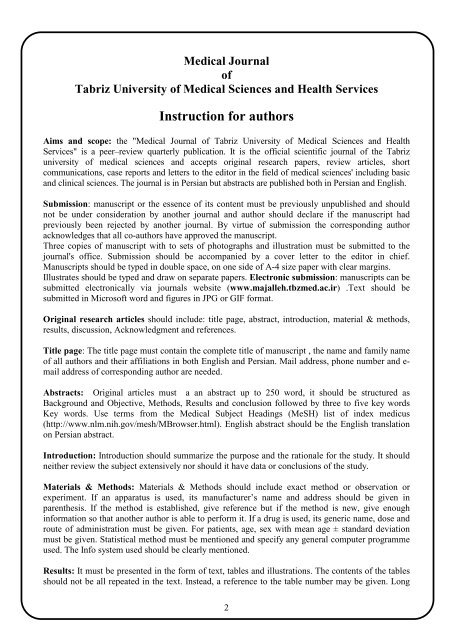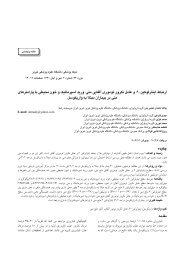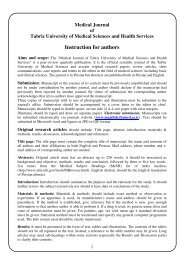Instruction for authors
Instruction for authors
Instruction for authors
Create successful ePaper yourself
Turn your PDF publications into a flip-book with our unique Google optimized e-Paper software.
Medical Journal<br />
of<br />
Tabriz University of Medical Sciences and Health Services<br />
<strong>Instruction</strong> <strong>for</strong> <strong>authors</strong><br />
Aims and scope: the "Medical Journal of Tabriz University of Medical Sciences and Health<br />
Services" is a peer–review quarterly publication. It is the official scientific journal of the Tabriz<br />
university of medical sciences and accepts original research papers, review articles, short<br />
communications, case reports and letters to the editor in the field of medical sciences' including basic<br />
and clinical sciences. The journal is in Persian but abstracts are published both in Persian and English.<br />
Submission: manuscript or the essence of its content must be previously unpublished and should<br />
not be under consideration by another journal and author should declare if the manuscript had<br />
previously been rejected by another journal. By virtue of submission the corresponding author<br />
acknowledges that all co-<strong>authors</strong> have approved the manuscript.<br />
Three copies of manuscript with to sets of photographs and illustration must be submitted to the<br />
journal's office. Submission should be accompanied by a cover letter to the editor in chief.<br />
Manuscripts should be typed in double space, on one side of A-4 size paper with clear margins.<br />
Illustrates should be typed and draw on separate papers. Electronic submission: manuscripts can be<br />
submitted electronically via journals website (www.majalleh.tbzmed.ac.ir) .Text should be<br />
submitted in Microsoft word and figures in JPG or GIF <strong>for</strong>mat.<br />
Original research articles should include: title page, abstract, introduction, material & methods,<br />
results, discussion, Acknowledgment and references.<br />
Title page: The title page must contain the complete title of manuscript , the name and family name<br />
of all <strong>authors</strong> and their affiliations in both English and Persian. Mail address, phone number and e-<br />
mail address of corresponding author are needed.<br />
Abstracts: Original articles must a an abstract up to 250 word, it should be structured as<br />
Background and Objective, Methods, Results and conclusion followed by three to five key words<br />
Key words. Use terms from the Medical Subject Headings (MeSH) list of index medicus<br />
(http://www.nlm.nih.gov/mesh/MBrowser.html). English abstract should be the English translation<br />
on Persian abstract.<br />
Introduction: Introduction should summarize the purpose and the rationale <strong>for</strong> the study. It should<br />
neither review the subject extensively nor should it have data or conclusions of the study.<br />
Materials & Methods: Materials & Methods should include exact method or observation or<br />
experiment. If an apparatus is used, its manufacturer’s name and address should be given in<br />
parenthesis. If the method is established, give reference but if the method is new, give enough<br />
in<strong>for</strong>mation so that another author is able to per<strong>for</strong>m it. If a drug is used, its generic name, dose and<br />
route of administration must be given. For patients, age, sex with mean age ± standard deviation<br />
must be given. Statistical method must be mentioned and specify any general computer programme<br />
used. The Info system used should be clearly mentioned.<br />
Results: It must be presented in the <strong>for</strong>m of text, tables and illustrations. The contents of the tables<br />
should not be all repeated in the text. Instead, a reference to the table number may be given. Long<br />
2
articles may need sub-headings within some sections (especially the Results and Discussion parts)<br />
to clarify their contents.<br />
Discussion: Discussion should emphasize the present findings and the variations or similarities<br />
with other work done in the field by other workers. The detailed data should not be repeated in the<br />
discussion again. Emphasize the new and important aspects of the study and the conclusions that<br />
follow from them. It must be mentioned whether the hypothesis mentioned in the article is true,<br />
false or no conclusions can be derived.<br />
Acknowledgement: All contributors who do not meet the criteria <strong>for</strong> <strong>authors</strong>hip should be covered<br />
in the acknowledgement section. It should include persons who provided technical help, writing<br />
assistance and departmental head who only provided general support. Financial and material<br />
support should also be acknowledged.<br />
Tables: all tables come at the end of the manuscript with references in the text. Do not submit<br />
tables as photograph. Place explanatory matters on footnotes, not in the heading. Tables data<br />
should not be repeated in the text.<br />
Figures: all figures, diagrams and charts should be in limited numbers and come at the end of the<br />
manuscript with references in the article. Figures legends should be appeared at the below.<br />
References:<br />
References should be numbered and a listed in order of appearance in the text . cite the number of<br />
all <strong>authors</strong> when there are six or fewer, when seven or more , list the six followed by et al. The<br />
references must be verified by the author(s) against the original documents. Listed below are<br />
examples of reference citation.<br />
1. Standard journal article<br />
Malekzadeh R, Varshosaz J, Merat S, Hadidchi S, Mirmajlesi SH, Vahedi H, et al. Crohn’s Disease:<br />
A review of 140 cases from Iran. Irn J Med Sci 2000; 25 (3 & 4): 138-143.<br />
2. Organization as author<br />
The Cardiac Society of Australia and New Zealand. Clinical exercise stress testing. Safety and<br />
per<strong>for</strong>mance guidlines. Med J Aust 1996: 164: 282-4.<br />
3. No author given<br />
Cancer in South Africa [editorial]. S Afr Med J 1994; 84: 15.<br />
4. Article in a <strong>for</strong>eign language:<br />
Lahdes–Vasama TT,Lamminen AE, Merikanto EOJ, Peltonen JI. Le cartilage de croissance dans<br />
l’ostéochondrite primitive de hanche: Etude prospective en IRM. Rev Chir Orthop 1995; 81 (5):<br />
395-403 (French).<br />
5. Volume with supplement:<br />
Shen HM, Zhang QF. Risk Assessment of nickel carcinogenicity and occupational lung cancer.<br />
Environ Health Perspect 1994; 102 (Suppl 1): 275-82.<br />
6. Book:<br />
Blunth EI, Arger PH, Benson CB, Ralls PW and Siegel MJ. Ultrasound: A Practical Approach to<br />
Clinical Problems. 1st ed. New York, Thieme, 2000; PP: 257-69.<br />
3
7. Chapter of a book:<br />
Kastner DL. Intermittent and Periodic Arthritic Syndromes. In: Koopman W J, ed. Arthritis and<br />
Allied Conditions: A Textbook of Rheumatology. 13th ed. Baltimore; Williams & Wilkins, 1997;<br />
PP: 1279-1306.<br />
Case reports: case reports should be arranged as following: title page, abstract( non-structured and<br />
not exceeding 150 words), introduction, case presentation , discussion and up to 13 references.<br />
Brief communication: original research paper can be published in a brief <strong>for</strong>mat. An unstructured<br />
abstract not longer than 150 words, the body of the manuscript should not exceeds 1500 words. It<br />
should comp comprise: introduction, material and methods, results and discussion with no more<br />
than two table or figures and up to 15 references.<br />
Letter to editor: letter to the editor will be considered if they contain significant comments or<br />
contains criticism on previously published articles in the “Medical Journal of Tabriz University of<br />
Medical Sciences”. Reports of limited researches or clinical experiences can be submitted in the<br />
<strong>for</strong>m of a letter. Letters need no abstract and should have no more than 400 words and no more than<br />
five references.<br />
Proof Reading: the editorial office will send proofs of the manuscript to the corresponding author<br />
<strong>for</strong> proof reading, corrections and return within the stipulated time. After the corresponding author<br />
has signed the galley proof, they will bear the burden of responsibility <strong>for</strong> any publication errors.<br />
Ethical consents: all manuscript reporting experimental investigation involving human subjects<br />
should include a statement confirming the in<strong>for</strong>med consent and that the study was approved by the<br />
local ethical committee. For those investigators who do not have <strong>for</strong>mal ethics review committee ,<br />
the principles outlined in the declaration of Helsinki should be followed. Was obtained from each<br />
participant or from the parents or legal guardians of minors. If the work involves experimentation<br />
on living animals , the author(s) must provide evidences that the study was per<strong>for</strong>med in accordance<br />
with local ethical committee guidelines or National Institutes of Health guidelines <strong>for</strong> the humane<br />
use of laboratory animals.<br />
Conflicts of interest: Authors must acknowledge and declare any sources of funding and potential<br />
conflicting interest, such as receiving funds or fees by, or holding stocks and shares in, an<br />
organization that may profit or lose through publication of your paper. Declaring a competing<br />
interest will not lead to automatic rejection of the paper, but we would like to be made aware of it.<br />
Copyright: the Medical Journal of Tabriz University of Medical Sciences &Health Services is the<br />
owner of the published material and are protected under international copyrights. However, all<br />
published works are open access and are available at the journal’s website. No part of this<br />
publication should be translated, transmitted or reproduced without permission from the publisher<br />
Abbreviations and symbols: Use only standard abbreviations. Avoid using them in the title and<br />
abstract. The full term <strong>for</strong> which an abbreviation stands should precede its first use in the text unless<br />
it is a standard unit of measurement.<br />
Guidelines <strong>for</strong> fonts:<br />
Persian Sections: title: yagut 15(bold); name and address of author(s): yagut 10, title of sections<br />
(abstract, introduction, methods and material, results, discussion, conclusion, acknowledgement and<br />
4
eferences): yagut 14 (bold); abstract: louts 11, titles in abstract (background and objective, methods<br />
and materials, results, conclusion and key words): yagout 11(bold), text of the paper: lotus 12.<br />
English abstract: title: times new roman 14(bold), name and address of author(s): times new roman<br />
10 (bold Italic), subtitles (background and objects, methods and materials, conclusion and key<br />
words): time new roman 11(bold), abstracts text: times new roman 11.<br />
Peer review process: All manuscripts are first internally peer reviewed by the editorial board to<br />
decided whether the manuscript is the type of article to be appeared in the journal and if so it has an<br />
adequate standard to be sent <strong>for</strong> external review. Approved papers will be send to two or three<br />
external peer-reviewers. If the comments from two reviewers differs markedly the editor may ask<br />
<strong>for</strong> comments from an arbiter reviewer. Authors are notified as soon as possible about the editors<br />
decision to accept, reject or revision. Authors could follow the final status of their manuscript on the<br />
journals website.<br />
Page charges: There are no charges <strong>for</strong> publication in this Journal.<br />
Disposal of material: after the manuscript was published, all hard copies of the manuscript,<br />
correspondences and artwork will be held <strong>for</strong> 6 months be<strong>for</strong>e disposal.<br />
The Final Checklist:<br />
To make sure that your manuscript meets all the requirements, please use the following<br />
checklist.<br />
1. Title page should contain title, name of the author/co-<strong>authors</strong>, their affiliations, mailing address,<br />
E-mail address, phone & fax number.<br />
2. Abstract in structured <strong>for</strong>mat up to 250 words.<br />
3. References, as stated in reference section.<br />
4. Tables should be appeared on separate pages.<br />
6. Make sure <strong>for</strong> headings of tables and illustrations, their numbers and captions. Don’t repeat the<br />
tables in<strong>for</strong>mation’s again in the text.<br />
7. Photographs / illustrations along with their captions.<br />
9. copyright <strong>for</strong>m signed by all the <strong>authors</strong>.<br />
10. Disclosure regarding source of funding and conflict of interest, ethical considerations described<br />
very clearly.<br />
11. Covering letter<br />
The Editor-in-Chief,<br />
Medical Journal of Tabriz University of Medical Sciences and Health Services<br />
No. 14, Panahi Street, Imam Khomeini Avenue, Post Code: 51656-87386 Tabriz, Iran<br />
Tel: +98 411 3363870, Fax: + 98 411 3366579<br />
E-mail: tbzmedmag@yahoo.com<br />
http://majalleh.tbzmed.ac.ir<br />
5



![ôfyÃ⡠ºÃ»â¬e ½Z» c|» ÃËÃZ¬» µÃ» |¿Z§ ÃÃ
Zó {Z¼a Z] ½Z¼Ë¿Za â°Ã ...](https://img.yumpu.com/51083675/1/184x260/aafyaa-aaaae-a-1-2-za-c-a-aeazaa-auaa-aza-aazaa-za-1-4-a-z-a-1-2-za-1-4-eaza-aa-.jpg?quality=85)
![ºy ÿÃfËÃ{ Ã^Ë¿ µâ¬fï Z] â à ÃfÃâ¡Ãf¿Z¯Yà ÿ à Z¼Ã] { û ®à ⰠYâ³ à ...](https://img.yumpu.com/45196844/1/184x260/ay-aaafea-aea-auafaa-z-a-a-afaaafazaya-aa-a-za-1-4-a-aa-ara-a-yaa-a-.jpg?quality=85)
![ó{â¬Ë§Y ºWß Å Ã
Z¯ { ÃfyZÃâ¹Yâ¬Â§ ½Z» { ÃÅz]â¬iY [Yâ¬ËâY |»MZ¯Z¿ Z ...](https://img.yumpu.com/38078895/1/184x260/aaaeay-awaa-a-aza-afyzaayaa-a-1-2-za-aazaiy-yaeay-amzaza-z-.jpg?quality=85)
![Y ÃZÃ
â¬f»Y Za ÃÃ
Z» Å â¹ Ãâ¡ â¬] Ãe â¦ÃÃ{Y µZfËÃ{ ôfË°⹠çYâ¬Â³Ãà ` C à ...](https://img.yumpu.com/38078886/1/184x260/y-azaafay-za-aaza-a-a-aa-a-ae-aaay-auzfea-aafeaa-aayaaaa-c-a-.jpg?quality=85)
![q ÃZÃ
|Ãâ¡Y ¶ÃZ§Ãâ¬a â¬Ãäe ÃZÃâ¹Ã³â¬y { { Z°ÃaY Ã]â¬qd§Z] [ Ã|â¹ ÃÃ~¤e Z ...](https://img.yumpu.com/38078756/1/184x260/q-aza-aay-aazaaaa-aaaae-azaaaaay-zaaay-aaqdaz-a-a-aaae-z-.jpg?quality=85)




